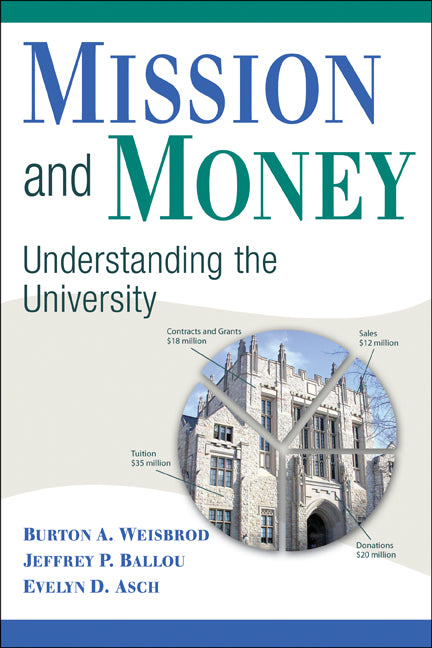Freshly Printed - allow 8 days lead
Couldn't load pickup availability
Mission and Money
Understanding the University
This book examines the entire higher education industry and includes the rapidly growing for-profit schools.
Burton A. Weisbrod (Author), Jeffrey P. Ballou (Author), Evelyn D. Asch (Author)
9780521735742, Cambridge University Press
Paperback, published 29 March 2010
356 pages, 15 b/w illus. 22 tables
22.9 x 15.2 x 2 cm, 0.48 kg
'When the Attorney General of the United States some years ago filed an antitrust action against a dozen top universities for comparing among themselves how much aid to offer scholarship students, he underscored just how far we'd come from the idyllic years in which higher education stood apart from the rest of the American economy. Today everyone recognizes that private and public research universities, liberal arts colleges, community colleges, and for-profit schools form a highly competitive industry, perhaps the nation's most important engine of economic growth. But no one understands better than Burton Weisbrod and his co-authors the complex commercial forces that are transforming the business and its managers. The action in their book stretches from the admissions office, the football stadium, and the biotech labs to corporate boardrooms, Madison Avenue, and the halls of Congress.' David Warsh, EconomicPrincipals.com and author of Knowledge and the Wealth of Nations: A Story of Economic Discovery
Mission and Money goes beyond the common focus on elite universities and examines the entire higher education industry, including the rapidly growing for-profit schools. The sector includes research universities, four-year colleges, two-year schools, and non-degree-granting career academies. Many institutions pursue mission-related activities that are often unprofitable and engage in profitable revenue raising activities to finance them. This book contains a good deal of original research on schools' revenue sources from tuition, donations, research, patents, endowments, and other activities. It considers lobbying, distance education, and the world market, as well as advertising, branding, and reputation. The pursuit of revenue, while essential to achieve the mission of higher learning, is sometimes in conflict with that mission itself. The tension between mission and money is also highlighted in the chapter on the profitability of intercollegiate athletics. The concluding chapter investigates implications of the analysis for public policy.
1. An introduction to the higher education industry
2. The higher education business and the business of higher education - now and then
3. Is higher education becoming increasingly competitive?
4. The two-good framework: how and why schools are alike and different
5. Tuition, price discrimination, and financial aid
6. The place of donations in the higher education industry
7. Endowments: financing the mission
8. Generating revenue from research and patents
9. Other ways to generate revenue - wherever it may be found: lobbying, distance education, and the world market
10. Advertising, branding, and reputation
11. Are public and nonprofit schools 'businesslike'? Cost-consciousness and the choice between higher-cost and lower-cost faculty
12. Not quite an ivory tower: schools compete by collaboration
13. Intercollegiate athletics: money or mission
14. Mission or money: what do colleges want from their athletic coaches and presidents?
15. Concluding remarks: what are the public policy issues?
Subject Areas: Political economy [KCP], Economics [KC], Higher & further education, tertiary education [JNM]


